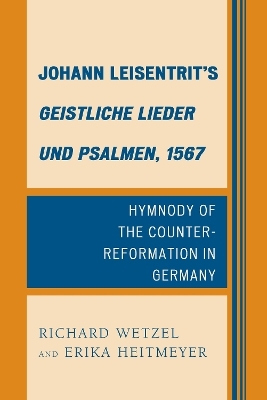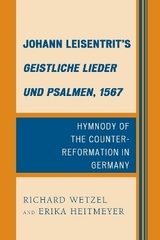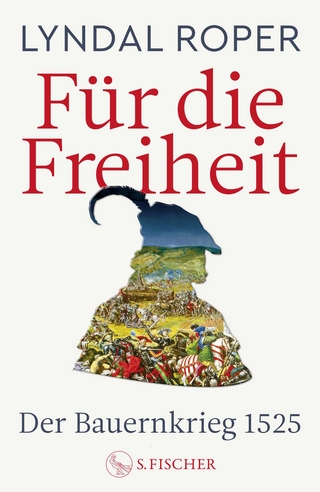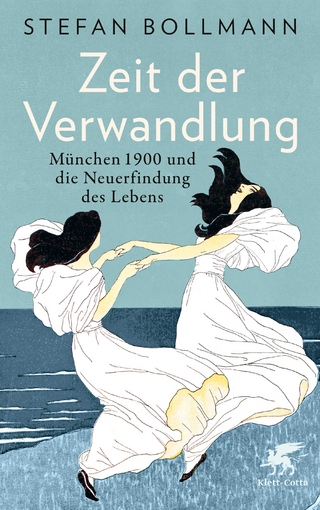Johann Leisentrit’s Geistliche Lieder und Psalmen, 1567
Fairleigh Dickinson University Press (Verlag)
978-1-61147-550-0 (ISBN)
Containing approximately 260 texts set to 175 notated melodies, many borrowed from Protestant sources and adapted to serve Roman Catholic objectives, Leisentrit’s book was the second Catholic hymnbook to be published in the sixteenth century. It surpassed its Protestant and Catholic precursors in scope and provided a model for the profusion of hymnbooks of numerous confessions that appeared in Germany in the seventeenth and eighteenth centuries .
Wetzel and Heitmeyer present their study in two parts: The first comprises six contextual chapters that survey earlier German achievements in hymnody, provide analyses of the texts and music in Leisentrit’s book, and assess his achievement within the volatile environment of the Counter Reformation. The second gives the melodies in modern notation along with the first stanzas of the texts; provides detailed concordances and references to sources that identify textual and musical provenances; and concludes with six appendixes to facilitate scholarly cross-references. Fourteen of the seventy wood engravings from Leisentrit’s book, many of which are visual representations of the prevailing confessional conflicts, are given in enlarged reproductions.
The authors provide the only comprehensive study in English of a unique religious figure and his efforts to achieve confessional reconciliation in the decades following the Council of Trent. They add to a more accurate interpretation of the relationship between Lutherans and Catholics in the sixteenth century and support the hypothesis that some Lutherans remained more liturgically formal than their Catholic contemporaries.
Richard D. Wetzel earned the Ph.D. in Musicology at the University of Pittsburgh, where he studied under Dénes Bartha, Theodore Finney and Robert J. Snow. Wetzel is on the faculty of the School of Music of Ohio University, Athens, Ohio. Erika Heitmeyer studied Germanistik and Latin philology and was director of studies at Gymansium schools in Dortmund, Germany. She received her Ph. D. in literary science with honors (summa cum laude) from the UniversitŠt OsnabrŸck, where she studied with Albert Gerhards, Winfried Woesler, and Ulrich Klein. Her articles and essays have been published in various scientific and theological magazines and anthologies.
Contents
Preface
Part 1 Context, Format and Style
Chapter 1 Johann Leisentrit and the Council of Trent Decades
Chapter 2 Early Sixteenth Century Hymnbooks
The Protestants
Johann Walter, Geistliche Gesang BÙchleyn, 1524,
1525
Michael Weisse, Ein New Gesengbuchlen, 1531
Joseph Klug, Geistliche lieder, 1533, 1535
Valentin Babst, Das Babstsche Gesangbuch, 1545
Lucas Lossius Psalmodia hoc est Cantica sacraƒ, 1553 Nikolaus Herman Sonntagsevangelia, 1561
The Catholic Pioneers
Michael Vehe, Ein new GesangbÙchlin Geystlicher Lieder, 1537
Georg Witzel, Psaltes Ecclesiasticusƒ, 1550
The Printers
Georg Rhau
The Wolrabs
Chapter 3 The Texts of Geistliche Lieder und Psalmen, 1567
Commendations and Endorsements
Instructional Texts
Hymn Texts and Sources
Latin Texts and Melody Titles
German Texts and Sources
Leisentrit’s Process of Adaptation
Chapter 4 The Melodies of Geistliche Lieder und Psalmen, 1567
Printing, Notation, and Transcription Issues
Melody Sources
Mode and Style
Chapter 5 Illustrations, Borders and Symbols
Plates
Title Page to Das erste Theil
Leisentrit in Prayer
Leisentrit’s Coat of Arms
Dedication to the Holy Roman Emperor
Symbols of the Struggles of the Church with Heretics
Symbols of the Struggle for Correct Interpretation of Scripture
Celebrating the Eucharist with Cup and Loaf
Symbols of the Crucifixion, Resurrection, and Eucharist
The Murder of Abel by Cain
The Temptation of Christ
Administering Extreme Unction
Christ and the Seven Sacraments
A Pastor Teaching
Symbolic Portrayal of Simultaneous Lutheran Preaching and Catholic Celebration of the Eucharist
Chapter 6 Epilogue
Part 2 The Melodies and First Stanzas of Geistliche Lieder und Psalmen, 1567, Transcribed. Sources and Concordances
Appendix 1Melody Titles and Text Incipits in Order of Appearance in Geistliche Lieder und Psalmen, 1567
Appendix 2Alphabetical Index of Melody Titles with Text Titles or First Line Incipits
Appendix 3Alphabetical Index of First Lines
Appendix 4 Table of Modal Characteristics of the Melodies
Appendix 5Table of Wood Engravings and Subjects
Appendix 6 Latin Hymns and their Adaptations
Bibliography
General Index
| Verlagsort | Cranbury |
|---|---|
| Sprache | englisch |
| Maße | 165 x 239 mm |
| Gewicht | 712 g |
| Themenwelt | Kunst / Musik / Theater ► Musik |
| Schulbuch / Wörterbuch ► Lexikon / Chroniken | |
| Geschichte ► Allgemeine Geschichte ► Neuzeit (bis 1918) | |
| Geisteswissenschaften ► Geschichte ► Regional- / Ländergeschichte | |
| ISBN-10 | 1-61147-550-3 / 1611475503 |
| ISBN-13 | 978-1-61147-550-0 / 9781611475500 |
| Zustand | Neuware |
| Informationen gemäß Produktsicherheitsverordnung (GPSR) | |
| Haben Sie eine Frage zum Produkt? |
aus dem Bereich




